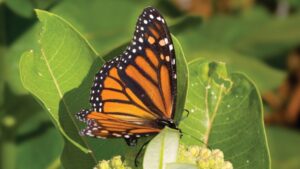As part of its research-based initiative, Living Acres, BASF is providing grants to Texas Tech University, the University of Arkansas and the University of Minnesota to research how to establish and maintain milkweed, the reproductive habitat for monarch butterflies and the only plant on which their larvae feed.
In the past two decades, the monarch butterfly population has declined due to a variety of factors, including loss of habitat. It’s estimated that the monarch has lost more than 165 million acres of habitat — an area roughly the size of Texas. As an iconic North American insect and a pollinator of fruits, nuts and vegetables, the monarch butterfly plays a vital role in our ecosystem and economy. Through Living Acres and its research partnerships, BASF aims to restore the monarch’s habitat by providing actionable guidance for farmers looking to cultivate milkweed in non-crop areas of their land.
“Restoring the monarch butterfly population will require collaboration from various entities and landowners,” says Luke Bozeman, BASF director of research and development for Crop Protection. “Through these partnerships, BASF and university researchers will be able to share rich insights and determine the best approach for growing and restoring the monarch butterfly habitat.”
Led by experts in environmental and agricultural research, the universities will evaluate how to increase the monarch habitat and how the agricultural community can make an impact. Below is a summary of the research partnerships and objectives:
Texas Tech University
- Establish demonstration sites for milkweed plants in the Rolling Plains Ecoregion of West Texas
- Evaluate and quantify monarch butterfly utilization of these milkweed stands
- Enhance the understanding of the value of milkweed in growing monarch butterfly populations
University of Arkansas
- Evaluate changes in the monarch butterfly habitat over the past 25 years
- Analyze the current land available for monarch butterfly habitats in the U.S.
- Investigate the potential for restoring and expanding monarch butterfly habitats
- Develop a migratory flyway habitat restoration and conservation plan for monarch butterflies
University of Minnesota
- Determine the feasibility of programs that rely on farmer participation to promote biodiversity on the farm landscape
- Identify the types and numbers of farmers likely to participate in milkweed establishment and maintenance programs in support of the monarch butterfly
Living Acres started as a research initiative at the BASF research farm in Holly Springs, North Carolina. The program aims to guide farmers looking to increase biodiversity on their operations. The first issue Living Acres is helping to address is the monarch butterfly population.
According to BASF research, farmers are uniquely positioned to positively impact the monarch habitat. With an upfront investment, farmers can establish milkweed plots in non-cropland areas of their farms, such as ditches, roadsides, alleyways and border areas. Restoring the monarch population is important for agriculture production systems and allows farmers to further demonstrate their role as stewards of the land.












